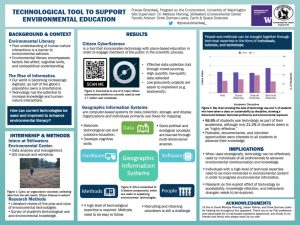Technology As Science Communication Tool To Benefit Environmental Education
With close to half of the global population owning a smartphone, access to information and communication is greatly increased. Historically, environmental fields have a poor relationship with technology as it has caused nature deficit disorder in younger populations. Environmental informatics is an underdeveloped field of study. The purpose of this research is to outline innovative ways in which technology can be used to advance environmental education and to highlight any gaps in technological use in the environmental field. For this study, a literature review was used to understand the current benefits and challenges of two common tools used by environmental organizations: citizen cyberscience and geographic information systems (GIS). During my internship, a GIS manual and workshop were executed to train staff and volunteers of the Stillwaters Environmental Center. Finally, a survey of collegiate students administered to gauge their interactions with technology and environmental-related content. GIS and citizen cyberscience were found to advance environmental literacy through cognitive skill-building and the development of socio-political knowledge. Volunteer retention and project granularity the biggest challenges to mass-implementation. A high level of environmental and technological literacy is required to implement these projects. Survey results indicate that students with higher technical ability are less likely to positively interact with the environment. By understanding the intricacies of informatics and sociocultural contexts, environmental scientists will be able to design, implement, and teach efficient communication and education tools to reach a wider audience.
